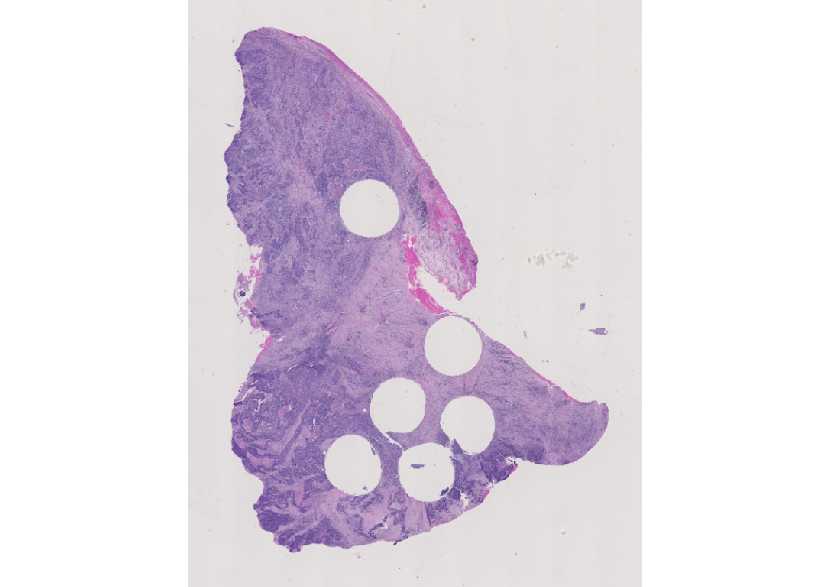Brief Description
This wiki is dedicated to hosting materials and enabling communication regarding the develoment of phantoms toward the evaluation of WSI.
Microbeads are plastic microspheres that can be immobilized in different patterns, sizes (diameters) and colors onto a glass slide substrate in a mono layer. This approach gives the possibility to create microscope glass slides with a mono layer of well-defined spherical objects with small geometrical tolerances in a certain pattern and structure which makes it very suitable for modelling and specific WSI performance testing. The patterns and structures on the slides can be created by a single type of microbead but also by a mixture of sizes and or colors (see figure 1).

Figure 1 Example of a pattern with different types of microbeads onto a microscopic glass slide. In the right upper corner a window with larger magnification is shown.
The bead spotting on the slide can be done by hand but preferably by a printer to obtain reproducible patterns. Both the micro beads and the slides are coated with functional groups to ensure the immobilization of the mono layer. This principle is presented schematically in figure 2.

Figure 2 Immobilization of microbeads monolayer on microscopic glass slide
Status
Under Development: Recruiting authors and reviewers
Other Options:
Ready for Science-Sharing Seminar: See page with session proposal
Ready for Drafting for White Paper: See page with authors and outline
Published
Authors
Chronicle authors and contributors and their contributions/role (author, editor, date). Please include links to NCIPhub profile pages to facilitate messages to page contributors.
Sjef Box, author of first version of Wiki page, 2016 March 11, https://nciphub.org/members/?id=2701&active=profile
Overview
Why Important
Technical performance measurement of WSI systems is important to ensure a proper and reliable operation of the system. For a reliable quantification it is important that the test covers the relevant system performance aspects and also has good modeling properties to ensure robust quantification of the results. Microscope slides with a mono layer of micro beads have the following properties to enable such modeling:
– well defined spherical shape with small geometrical tolerance,
– defined mixture possible with selection of specific sizes and/or color,
– defined pattern and structure of microbeads onto WSI slides.
This creates the possibility to manufacture microscope slides that are optimized for specific WSI technical performance testing.
Related System Components
The microscope slides with microbeads can be used in system level tests of WSI systems which include in principle all system components. In the Technical Performance Assessment of Digital Pathology Whole Slide Imaging Devices (see ref.1) the following system level tests are described:
– IV(B)(1): Color Reproducibility
– IV(B)(2): Spatial Resolution
– IV(B)(3): Focusing Test
– IV(B)(4): Whole Slide Tissue Coverage
– IV(B)(5): Stitching Error
For some of the tests mentioned above slides with microbeads patterns can be interesting. Some examples are given below:
– focusing test (see figure 3)
– stitching error test (see figure 4)
– whole slide tissue coverage (see figure 5).
Other possible tests for which microbeads slides can be used are:
– line and field uniformity
– chromatic abberations.
– light intensity calibration (see ref. 2)

Figure 3 Example of slide that can be used for focus testing based on beads with different colors and two different sizes

Figure 4 Example of slide that can be used for system level stitching error test in combination with automated algorithm

Figure 5 Example of slide that can be used for whole slide tissue coverage system level test using a specific pattern and a mixture of microbeads with small amounts of different sizes and colors
Materials and Methods
An overview of the properties of the microbeads that have been used to create slides are listed below:
| material | polystyrene |
| diameter range | 0.2 … 20 µm |
| coefficient of variation (Cv) | 2 … 6% (depends on type and size) |
| color | blue, red, violet, yellow |
| density | 0.96 … 1.04 g/cm3 |
| refractive index | ~1.6 |
How related to tissue and the pathologist
The examples shown can be further improved or optimized for the specific system level test or to test typical aspects of real tissue slides. It is also possible to combine several patterns and structures on one slide to create a single slide that contains several system level tests at different slide locations.
Chronology of Progress
Document the discussions (when, where, what) and provide links to related slides.
- Oct. 12, 2015: Sjef Box (Philips Research), “Phantom Development Approach Proposal for Measurement Method,” presentation given at the joint session of the WSI WG and DPA at Pathology Visions, Boston, MA. Phantom_Direction_PV2015.pdf (1 MB, uploaded by MARIOS GAVRIELIDES 8 years 6 months ago)
References
Format: authors (year), title, journal, volume, page, and then link to listing on journal website and the National Library of Medicine.
External Links to Related Information
Ref. 1 – Technical Performance Assessment of Digital Pathology Whole Slide Imaging Devices – Draft Guidance for Industry and Food and Drug Administration Staff, 2015 Feb 25.
Ref. 2 – Use of green fluorescent beads fixed on glass microscope slide to calibrate the LED light intensity of the Inova NOVA View Automated Fluorescence Microscope (see DEN140039_-_NOVA_view-2015.pdf (222 KB, uploaded by Sjef Box 8 years 1 month ago), page 5)
